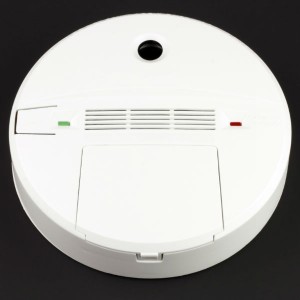Most home-owners who are lucky enough to have a fireplace know the steps to prevent them from causing harm to their families and houses. Most will tell you about how you should only burn seasoned wood, never leave fires unattended, and always keep you chimney inspected and clean but a surprising few will tell you about one of the most potentially dangerous aspects of owning and operating these wonderful additions to their homes.
According to the United States Fire Administration more than 150 people a year die from carbon monoxide poisoning from faulty or improperly used or ventilated fuel-burning appliances including fireplaces. Carbon Monoxide is produced as a byproduct of burning fossil fuels and if not ventilated properly (either because of blockages or leaks in the ventilation system or something as simple as forgetting to open the damper of a fireplace) can cause unconsciousness and death in an adult human in less than ten minutes. The most dangerous aspect of CO (carbon monoxide) is that is odorless, tasteless, and invisible meaning that it is completely undetectable to humans without the aid of a Carbon Monoxide detection device.

In order for carbon monoxide detectors to work properly, your batteries must also be working. Check them twice a year.
To understand what makes carbon monoxide so deadly you must first understand how the human respiratory system works. When you breathe oxygen is pulled into your lungs where it permeates the walls and loosely attaches itself to iron atoms inside hemoglobin in your bloodstream. As your blood travels through your body the oxygen detaches itself from the iron in your blood when it comes to an area of your body that is lacking in oxygen. When the iron returns to your lungs it picks more oxygen and continues the process supplying your brain, muscles and other vital organs with the oxygen they need to function. Whereas oxygen attaches itself loosely to the iron carbon monoxide attaches much more securely. This essentially prevents that iron atom from picking up and transporting oxygen. If you get enough carbon monoxide in your bloodstream oxygen will no longer reach the necessary parts of your body. When a person is suffering from carbon monoxide poisoning they can be breathing very deeply but none of the oxygen gets to where it needs to go. They will die from suffocation.
While the thought of this “silent but deadly” gas is rightfully distressing there are simple steps everyone can take to prevent the tragic effects of carbon monoxide poisoning. The single most important thing is to install a carbon monoxide detector. These work similarly to fire detectors in that they will produce an alarm when they detect unusually high traces of carbon monoxide in the air in your home. Just as you would train your children to know what the fire alarm sounds like you should also train them to know what the carbon monoxide alarm sounds like. When the alarm goes off it is important to get outside or at the very least near an open window and immediately call 9-1-1.
Additional steps that should be taken involve prevention. Some of the appliances that can produce carbon monoxide are fireplaces, furnaces, wood or coal stoves, water heaters, and space heaters. All of these should be regularly inspected. Always makes sure your damper is open when using your fireplace. Never use an oven or stove top to heat your home. Make sure all ventilation leads to outdoors. Never ventilate to another portion of the house. Make sure all ventilation is clean and clear allowing the venting process to occur unobstructed. Never leave a running car in a closed garage. On average a person in a closed 2 car garage with a running car will be dead in 5-10 minutes. Always use grills outside. Never use generators indoors. These simple steps go a long way in preventing carbon monoxide buildup.
Carbon monoxide is certainly not something to be taken lightly but if you take the proper steps in prevention and detection you and your family will be safe and sound. And remember if you have any doubts about the ventilation of your fireplace, wood stove, or dryer vents call your chimney sweep to come out and perform an inspection. It is always better to be safe than sorry.
